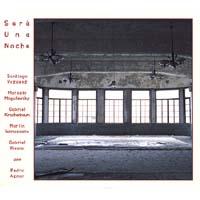m a recordings Returns to Vinyl
Todd Garfinkle’s simply miked, spacious-sounding 96K DAT recordings have earned him a following among audiophiles, even though most of the music Garfinkle prefers to record is anything but traditional audiophile fare.
Garfinkle’s recordings create spacious, transparent three-dimensional soundstages, Technicolor-like harmonics and dramatic dynamics. While the music Garfinkle records isn’t tailored for 21st Century audiophilia the way, say, Persuasive Percussion was during the 1960’s, it often tends to be a dramatic, almost theatrical style of “world music” that lends itself well to open spaces and the production of large percussive dynamics.
No doubt m a recordings has attracted a following beyond the audiophile marketplace because Garfinkle is, above all, a musician and an ethnomusicologist who manages to find, record and expose some highly talented performers and groups, placing them in moody, atmospheric settings, both sonically and musically. There is an m a recordings esthetic, both sonically and musically, as well as graphically. In some ways, Garfinkle reminds me of Will Ackerman, though that’s a comparison I’m sure he’d rather I not make!
Será Una Noche isn’t the first title he’s issued on vinyl. In fact one of the others, Begoná Olavide’s Salterio has a “placeholder” on this site http://www.musicangle.com/album.php?id=170
where a review was supposed to go. It just never happened, sorry to say. At least this one has!
This appears to be a group of musicians assembled for the recording and not a working group, unless the name of the group is the album title. It’s hard to know because the notes don’t tell you.
In any case the music on the album is all based on the Tango, an Argentinian creation circa 1900 fused from music brought there from Italy, Spain, Germany and Africa. Tango has the fire of Flamenco, the romance of Italy and the signature sound of the Germany-originated, accordion-like bandoneón.
With names like Pedro Aznar, Gabriel Kirschembaum, Marcelo Moguilevsky and Santiago Vazquez, the six players on this album are as multicultural as the music they play. Where it was recorded and what space is shown on the cover photo, and whether or not it is the space in which this was recorded, we’re not told.
What you have here is atmospheric, smoldering, dramatic Tango-based compositions, mostly sinewy instrumentals, arranged for flute, clarinet (including an almost menacing bass clarinet), cello, bandoneón, guitar and percussion (mostly persuasive) that leave large hunks of open space between the notes and between the instruments. They are as much soundscapes as songs
The playing is compelling, accomplished and organic and some of the compositions are confident and memorable, but there’s filler too, some of which exposes a shallowness of purpose that detracts from the overall impression. After a while, the tracks pile up and began meandering. It would have been better to issue a shorter, more concise collection because I’m not sure how this will keep your full attention for as long as it runs, which is well over an hour.
Still, the sound is absolutely spectacular, the space produced enormous, the percussion thundering, the guitar textured and the bandoneón liquid and breathy. The shear physicality and visual solidity of the production will keep you enthralled from the start. For how long, it’s difficult to say, but I’d bet for at least the first half dozen tunes that run more than forty minutes.
I compared the XRCD and the double vinyl cut by Thorsten Scheffner in his studio in the German countryside outside of Munich and pressed at Pallas. I got to visit when I was in Munich Spring 2007 and will try to post some pictures of the place as a feature on the site.
The vinyl, cut from the 96/24 master sounds far more open, spacious and dynamic than the XRCD, at least on my rig, though of course it’s all L-R , IM and harmonic distortion. Beyond that, the LP sounds so much more real and alive, it’s ridiculous. You should check it out.



